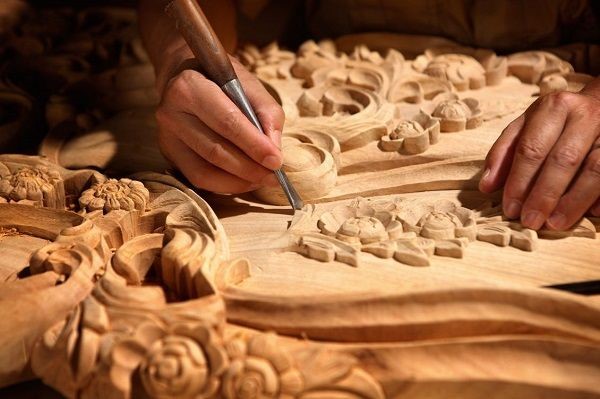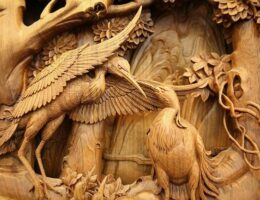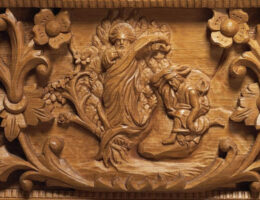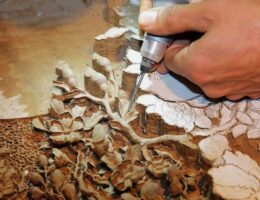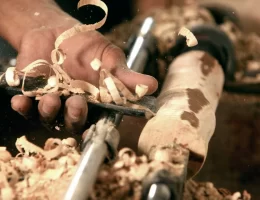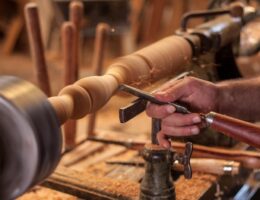IRAN ART EXHIBITION: EVERYBODY STARES AT PERSIAN MONABAT-KARI OR WOODCARVING!
Monabat Kari is a branch of wood industry that is considered an artistic technique. It involves carving on wood and a woodcarver is someone who does the carving on the wood. This is a Persian Handicraft dating back to a time where humans acquainted with sharp tools and started to cut wood. In Iran, it has a long history and is a reminder of the past. It can be argued that the Iranian wood carving art history goes back to the first time Iranian got to know wood, making the history of wood inseparable from the history of Monabat Kari, therefore, wood carving has come a long way in reaching the present state. Currently, this art is a prevalent activity all over Iran with cities like Golpayegan, Esfahan, Shiraz, Abade, Malayer, Shahrod, etc, being the leaders.
History of Wood Use in Iran
According to the research and findings of the historians, using wood in Iran dates back to the stone age. Using wood to build houses by the indigenous people of Iran before the Aryan migration is considered to be 4200 BC. The ancient Iranians used wood to make various tools and the pieces of wood obtained in one of the tombs of Fasa city in Fars province 5000 years is a testament to this fact.
In the Timurid era, the wood carving style of the Mongols continued and of the good examples of this era, one can refer to the two-door belonging to the second half of the fifteenth century, which are preserved in the Metropolitan Museum. During the Zandiyyah and Qajar period, Monabat Kari declined and smaller pieces like mirror frames replaced the construction of huge inlaid doors and pieces.
The Wood Used for Iranian wood carving art
The most important basic material in Iranian Monabat Kari is wood. Choosing the best wood for wood carving is one of the most essential steps in this art. Wood is a product of trees. The kind of wood appropriate has a fine and firm texture, which is usually obtained from trees with broad leaves. Of course, not every tree with broad and wide leaves is not suitable for this art as they might have a coarse and heterogeneous texture. In the following we explain the woods used in Iranian Monabat Kari that are prevalent in Iranian markets:
Walnut tree wood:
walnut, cultivated in the majority of Iran, is native to Iran and China and is found in northern Iran up to 1500m above the sea level. The outer wood is gray tinged with light brown and the inner wood is light-to-dark brown. The wood is relatively heavy and can absorb paint to a good degree. It has regular and irregular fibers with beautiful motifs. This wood is one of the best woods for Iranian wood carving and has high strength.
Beechwood:
IRAN ART EXHIBITION: Beech grows in Europe, West Asia, Iran, and Turkey. In Iran, it is distributed from 650 to 2000 meters above sea level. The red outer wood and the reddish-brown inner wood have parallel and uniform fibers with no odor, relatively stiff, heavy, and relatively resistant to impact. It absorbs color to a good degree. After walnut, it is the best wood for Persian wood carving art and has high popularity in Iran.
Plane tree’s wood:
In Iran, Tehran in particular is one of the most abundant trees. The outer wood is light to reddish-brown. Its old wood resembles beech. Its wood is from broad-leaved families and is used in Iranian wood carving art.
The Essential Tools for Monabat Kari
Cave:
The cave is one of the most important wood carving tools in Persian wood craving that, despite the long passage of time, it hasn’t changed much, which is also the case for other tools of this craft. Caves are sharp tools usually comprised of three parts. Caves have a plastic or wooden handle. They are the most important tool for peeling and cutting. Overall, there are 4 types of caves used in Iranian wood carving art, with the rest being variations of these.
File:
Parts of a piece that has an arc or cannot be smoothed with other tools are finished by file. File has treads all over it. Files have different shapes and are generally classified into round, rectangular, triangular, semicircular, and flat categories.
Hammer:
It is used to hit the cave. The hammer used to be made by wood and now it is made of compressed plastic and/or wood. Of course, some woodcarvers make their own hammer and stick a thin rubber head on it. They use a wooden or plastic hammer for four reasons.
1. To reduce the noise when hitting a cave
2. To not damage the handle
3. Because it has a lighter weight than a metal hammer, making woodcarvers less tired.
4. Because the head of the wooden hammer is larger, hence it’s easier to work with.
How to transfer a pattern on wood for wood carving art
The following are ways by which a pattern can be transferred on wood.
Transferring a pattern by a carbon paper: In this method, first, we place the carbon paper on wood and then place the pattern on it, now, we gently draw the lines. IRAN ART EXHIBITION: After that, we remove the carbon paper and the pattern to see the final result on the wood. This pattern has numerous applications in Persian Monabat Kari.
Transferring a pattern directly: This method requires a skillful woodcarver with a total mastery of design to pull off the pattern directly on the wood.
The woodcarver should draw the pattern with complete symmetry. This is the simplest way to get the job done only if the woodcarver is well-versed in design.
Transferring a pattern by photocopy method: In this method, we photocopy a pattern and glue it on the wood. Then, we begin carving off the glued pattern. This method is good in terms of time-saving but the end result is not satisfactory.
Transferring a pattern by the needle method: In this way, the pattern is drawn on a paper and then the lines are dotted by a needle.
Afterward, some soot is poured into a thin sock and the pattern is laid on the wood and the sock is dotted, drawing an outline of the pattern. This method is too time-consuming to be used often by the woodcarvers.
Transferring a pattern by paper greasing: In this method, the pattern is drawn on a sewing paper and then submerged in oil. Afterward, the pattern is laid on a wood and a pencil is used to draw the lines, transferring the pattern on the wood. This is the most common method.
The Wood Craving Steps
• The woodcarver should first choose a pattern
• Then the woodcarver should transfer the pattern on a wood
• The workpiece should be attached to a clamp and if necessary, the wood surface should be oiled to be smooth
• After a while, the pattern should be separated from the background by a cave.
• Then, the background should be flattened and smoothed by a cave.
• Finally, the pattern should be shaped by various caves and be decorated.
Frequently Asked Questions
Which wood is best for woodcarving (Monabat Kari)?
IRAN ART EXHIBITION: Choosing the right wood is one of the most essential steps in this Iranian Handicrafts art. The wood carving master chooses the appropriate wood from various woods according to the color and material of the work.
* Walnut wood
* Pear wood
* Carnation wood elm
*Beech wood
* Tabrizi wood
Each of these woods has a unique color that contributes significantly to the ultimate beauty in artistic creations.
What are the most popular wood carving styles?
There are three ways to make wood carving (Monabat):
*Engraving
*Highlight
*Body sculpting
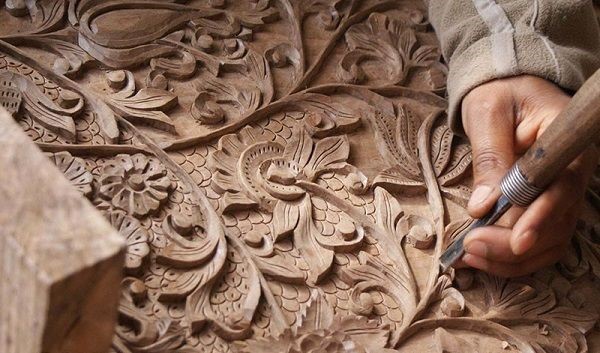
How do you start wood carving (Monabat Kari)?
1. A professional woodcarver must first and foremost have the power of visualization and be able to visualize the final Monabat kariin his mind.
2. Cut the lines in the drawings.
In this way, we cut all the lines that show the map and design with a knife and take them out of bed.
3. We take out the negative background floor and remove the removable parts from the inside of the work.
4. Open between the foliage. This stage has been one of the most important stages of wood carving. Because it will have the greatest impact on the effect. The more delicately and accurately the corrections are made to work, the more engaging the work of art will be.
5. At this stage, the finer lines and patterns, and the details and subtleties of the wood carving are more precisely.
6. Shaving the extra surfaces of the effect
What are the most important woodcarving tools?
Clamp, Monabat table, carpentry clamp, iron rasp, paper and fabric rake, stationery, oil or leather or kalk paper, plastic or wooden hammer, electric sharpener, Types of wood, wood glue, brush, nail, wardrobe, meter, petroleum, rubber, oil.
IRAN ART EXHIBITION: Persian art or Iranian art has one of the richest art heritages in world history with art such as; architecture, painting, weaving, pottery, calligraphy, metalworking, sculpture and wood carvings.
Wood carvings are achieved by:
• Fastening a piece of the wood which is going to be inlaid to the vice or is fastened to the worktable manual vice
• The background of the surface can be carved with the flat gouge. It can also be cut by a drill or saw. After cutting around the back¬ground, the carved-latticed work is made.
• Then some slight parts of the curves and inside the work are filed, which is called Seftkari or working on hard surface.
• Afterwards, some oil is poured on the worked surface to soften the wood and create an oily surface perfect for carving.
• Following that, the tip of the gouge is beaten slightly by the hand palm or an apparatus called Takhmagh to cut off around the work so that the background of the work is lowered as deep as needed, all the same in depth.
• Now it is the turn of polish¬ing the job with gouge or some apparatus called Lisseh.
• Some blows onto the tips of the different gouges with the palm of the hand to carve other parts of the job can be made. In this way curves, straight lines concave and convex parts of the woodcarving is achievable.
